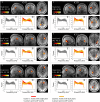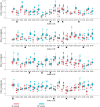Power spectra reveal distinct BOLD resting-state time courses in white matter
- PMID: 34716261
- PMCID: PMC8612352
- DOI: 10.1073/pnas.2103104118
Power spectra reveal distinct BOLD resting-state time courses in white matter
Abstract
Accurate characterization of the time courses of blood-oxygen-level-dependent (BOLD) signal changes is crucial for the analysis and interpretation of functional MRI data. While several studies have shown that white matter (WM) exhibits distinct BOLD responses evoked by tasks, there have been no comprehensive investigations into the time courses of spontaneous signal fluctuations in WM. We measured the power spectra of the resting-state time courses in a set of regions within WM identified as showing synchronous signals using independent components analysis. In each component, a clear separation between voxels into two categories was evident, based on their power spectra: one group exhibited a single peak, and the other had an additional peak at a higher frequency. Their groupings are location specific, and their distributions reflect unique neurovascular and anatomical configurations. Importantly, the two categories of voxels differed in their engagement in functional integration, revealed by differences in the number of interregional connections based on the two categories separately. Taken together, these findings suggest WM signals are heterogeneous in nature and depend on local structural-vascular-functional associations.
Keywords: fMRI; power spectra; resting state; white matter.
Conflict of interest statement
The authors declare no competing interest.
Figures




References
-
- Biswal B., Yetkin F. Z., Haughton V. M., Hyde J. S., Functional connectivity in the motor cortex of resting human brain using echo-planar MRI. Magn. Reson. Med. 34, 537–541 (1995). - PubMed
-
- Fox M. D., Raichle M. E., Spontaneous fluctuations in brain activity observed with functional magnetic resonance imaging. Nat. Rev. Neurosci. 8, 700–711 (2007). - PubMed
Publication types
MeSH terms
Grants and funding
LinkOut - more resources
Full Text Sources

